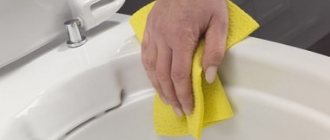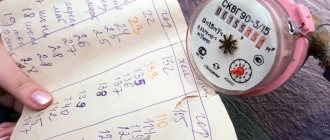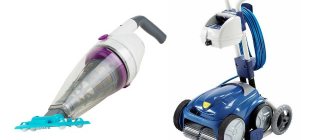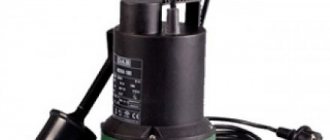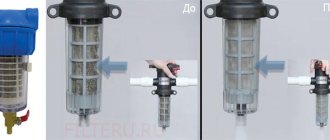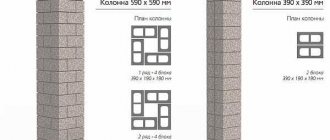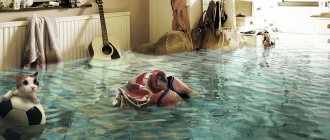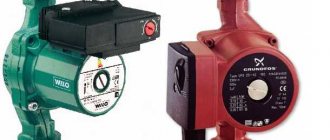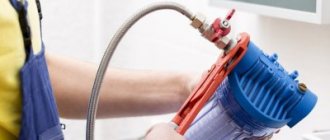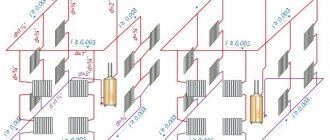The quality of water supplied to our homes does not satisfy the needs of all users. What can we say about those who extract it from a well on their site. Water contains many impurities that can harm human health. That is why the issue of cleaning it is so pressing for many. Today we will look at what a water filtration system for a home may include, learn about different cleaning methods, and see how the equipment is installed using the example of some solution.
Water filtration system for home
How do water filters work?
Choosing a filter is not an easy task, the solution of which should be approached responsibly. It is better to first understand how different water purification systems work. Their manufacturers use a variety of technologies, including:
- Filtration. Mechanical impurities in the form of sand and rust particles are removed from the water. Water passes through fibrous or porous materials, and the size of these pores can vary. The degree of filtration and performance are affected by the ratio between the sizes of pores and dirty particles. For example, filters with pores smaller than 0.45 micrometers stop bacterial particles and disinfect water.
- Sorption. This technology involves filtering organics, heavy metals and other chemicals. This happens due to their binding through intermolecular interaction. Thanks to sorption, the taste of water is improved and foreign odors are eliminated. One of the sorbents is activated carbon. For an antibacterial effect, carbon particles can be coated with iodine and silver ions. The sorption purification system has such a characteristic as capacity, which determines the amount of pollutants absorbed by the sorbent. Accordingly, cartridges require regular replacement.
- Ion exchange. Unwanted ions from drinking water are replaced with neutral ones. For example, to soften tap water, magnesium and calcium are replaced with sodium. The use of such filters is effective when it is necessary to remove heavy metals and fluorides, as well as add certain substances (iodine, fluorine, etc.).
- Reverse osmosis. Reverse osmosis systems purify water using semi-permeable membranes that allow particles ranging in size from 10 to 500 nm to pass through. For normal operation, reverse osmosis filters require sufficient water pressure, so the installation is additionally equipped with a pump. Depending on the size of the pores, reverse osmosis removes all impurities, including mineral components.
There are some other technologies for obtaining clean water. Among them are disinfection with ultraviolet light, ozone, iodine or silver ions, as well as active chlorine compounds. These disinfection technologies require additional mechanical water purification.
Stationary filters: cleaning methods
Most stationary three-stage filters use three methods:
- mechanical filtration: removal of mechanical pollutants;
- ion exchange: removal of the bulk of inorganics;
- sorption: removal of chlorine and organic matter.
For ferrous water, catalytic oxidation is also used - a reliable way to remove dissolved iron compounds.
Purification from biological pollutants is “incorporated” into ion exchange and sorption.
Sorbents fight bacteria. Metallic silver is added to the activated carbon used, which suppresses the vital activity of these microorganisms.
Viruses are resisted by ion exchange materials, especially the unique “Aragon” and “Catalon” (both know-how), which, thanks to their natural electric field, attract and destroy the bodies of viruses that have an electrical charge.
Types of water filters
A variety of filters can be used to improve the quality of tap water. They differ from each other in design, service life and operation.
Flow prefilters
One type of water filter is the so-called pre-filter. It is designed for mechanical cleaning and is built into a water pipe at the entrance to an apartment or house. The filter provides coarse filtration to protect home appliances and plumbing fixtures from rust and other particulate matter. This pre-filtration simplifies the operation of fine filters, and the cartridge becomes clogged more slowly. The design of such flow filters is very simple and consists of:
- mounting bracket;
- detachable connections for inserting into a pipe;
- body (most often plastic with a transparent bulb);
- replaceable cartridge made of synthetic materials.
It is allowed to install such main filters in apartments and dachas to purify consumed tap water from solid impurities. The choice of flow filter model depends on the volume of consumption. The use of such devices is strongly recommended where there are boilers, dishwashers and washing machines, boilers and geysers. Filters prevent hazardous mechanical impurities from entering household appliances.
Flow prefilters are installed not only in centralized water supply systems. You can also choose a filter for a water well at a dacha or in a country house - it will cope with its main task just as well. The main thing is to take into account the maximum pressure for which the filter bulb is designed. If it exceeds the permissible limit, the plastic case will burst.
Jugs
If you don’t know which water purification filter to choose for your home or apartment, start with a jug filter. It is convenient, inexpensive and provides a good degree of cleaning. Structurally, this home filter is very simple: a transparent container, shaped like a jug, has an insert on top with a cartridge, a lid and a spout.
To obtain purified water, you need to pour it into the upper container, and it will gradually seep down through the cartridge and fill the jug. As purified water is consumed, the upper container is filled with untreated tap water. Which water pitcher filter is best to choose depends on its quality. The models themselves, even from different manufacturers, are very similar, and the main differences are in the cartridges, which are:
- universal, filled with activated carbon;
- softening agents, which have ion exchange resins;
- iron retention impurities;
- health products with fluorine and other elements;
- disinfectants.
The filter part, called the cartridge, has a certain resource and requires periodic replacement, depending on the intensity of water consumption. To choose the best water filter in the form of a jug, you should decide on the manufacturer. Among the most popular brands are:
- Barrier;
- Aquaphor;
- Geyser;
- Brita.
The price of jug filters from these manufacturers starts from about 400 rubles, but also find out in advance the cost of replacement cartridges and calculate which model is more profitable. All jug filters have a number of characteristic advantages:
- stylish look;
- practicality and mobility - the filter does not require integration into the water supply system;
- different volumes of jugs - from 1 to 5 liters;
- ease of use;
- affordable price.
Among the disadvantages, you should pay attention to the low filtration speed (about 400 ml per minute) and the need to regularly replace cartridges. They have a limited resource and on average each of them lasts for about a month.
If you want to choose a water filter for your dacha, we recommend taking a closer look at these jugs. They are inexpensive and are used as needed. If you don’t go to the dacha often, one cartridge will last you for a long time.
Faucet attachments
The filter attachment on the faucet is attached to the spout and traps foreign matter. These devices may have different designs, but they are all flow-through. You can choose a good flow-through filter for cold water in almost every plumbing store or on the Internet.
The filter has a cylindrical shape and is filled with filter material inside. Most often it is activated carbon and crushed mineral, surrounded on both sides by membranes with small pores. Filters are disposable and dismountable with replaceable cartridges. The advantages of these simple household filters include:
- filtration, like jugs;
- large resource - up to several thousand liters;
- compact dimensions;
- variety of models and fillers;
- ease of installation;
- acceptable price.
When choosing such a flow filter, remember the disadvantages. Non-separable disposable models are impractical, and even with a low spout, the filter attachment will interfere with washing dishes or drawing water into tall pots or jugs. This filter can be installed at home or in the country.
Desktop filters
Tabletop filter attachments are less popular. The main difference from the previous type of filters is their more bulky sizes. The housing itself with the filter material is located separately - it is placed on the countertop near the sink and connected to the tap with a tube. The increased volume of the filter element increases performance compared to faucet attachments and increases service life. Traditionally, these filters have the form of vertical cylinders.
Rating of the best manufacturers
To make your task a little easier, we offer you a rating of the most popular (and for good reason) manufacturers of water filters. Perhaps this will narrow down your search.
At least, most filter buyers chose these brands.
No. 1 - filter for ICAR sink
Development of the Russian company Research Center “IKAR”, which is a manufacturer of installations for producing drinking water of the highest quality. The ICAR filter rightfully occupies a technological leadership in the household water treatment market.
The filter is equipped with a microprocessor unit for controlling and monitoring the output parameters of water: level of mineralization; control of reverse osmosis membrane contamination; water activation power (change in ORP); level of pH increase.
The ICAR filter is mounted under the sink and consists of:
- 5-stage premium reverse osmosis system - the degree of water purification is the highest among competitors (~ 98%) according to WHO criteria.
- patented module of the Research Center “Icarus”, which activates very fresh water, structures it and gives it a negative redox potential ( ORP) with an average value of -300. In this case, the ionization of water lasts from 3-7 days in the storage tank. Water boosts immunity and has antioxidant properties.
- The mineralization unit built into the module operates in automatic dosage mode using the injection method, which ensures the saturation of water with useful substances: K+, Ca++, Mg++, Se++, Iodine ions. Mineralization is carried out using the mineral additive “Severyanka Plus” No. 4. The additive consumption is calculated on average for a year of use.
The system has low power consumption - 50 W. The cost of the produced water of the highest quality is 3 rubles/l. Also, the Research Center “IKAR” has developed a pH reactor to raise the pH of water to values of 7.5 – 8.5, since the water leaves through osmosis with a lower value by about one unit from the pH of the input water, it is purchased separately.
It is believed that drinking water with such pH values increases overall life expectancy and helps maintain the acid-base balance of the body. The unique patented ICAR filter technology has won prestigious international awards in Switzerland and Belgium. The installation has no analogues in the world; the technology allows you to obtain clean, tasty and healthy water at home.
Among the disadvantages of the installation, the following can be highlighted: at first glance, the high cost of the system compared to filters of a lower class; it is also necessary to change replaceable reverse osmosis filter cartridges at least once a year (as with any other filter), once a year to purchase the Severyanka mineral additive plus" (cost about 1 thousand rubles). However, the output is water whose properties are comparable to water from Lake Baikal and its cost is 3 rubles. for 1 liter.
No. 2 - Russian Aquaphor, also known as Aquaphor
The well-known Russian brand Aquaphor produces all of the above types of water filters. In principle, this manufacturer can satisfy every buyer; there are offers for any budget.
AQUAPHOR is a manufacturer of a wide range of effective filtration systems that have earned a reputation for reliable equipment (+)
Cartridges for Aquaphor jugs can be purchased not only in specialized stores, but also in many large supermarkets. This is very convenient, since they will have to be changed with enviable regularity.
In the rating of jug-type filters for water purification of the Aquaphor brand, 3 popular models can be distinguished:
- Aquaphor Ocean;
- Aquaphor Prestige;
- Aquaphor Premium.
Aquaphor flow filters are available in a wide range. The innovative development of the manufacturer Aquaphor - the substance Aqualen - is used as a filter media.
This material is a variation of the polypropylene filter patented by this brand. Aquaphor offers flow filters with collapsible cartridges (you can add or change the filler) and non-separable cartridges (can be completely replaced).
Aquaphor is one of the few manufacturers that produces and offers a flow-through cleaning nozzle for the faucet
Top flow models:
- Aquaphor Trio;
- Aquaphor Crystal;
- Aquaphor Favorite.
Aquaphor reverse osmosis systems are also in great demand in our market due to their good quality, availability of consumables and components, and reasonable price.
The main element of the system, the membrane, is produced in China and Taiwan. This is considered a disadvantage of such filters. Reverse osmosis systems are represented by different versions of the Aquaphor OSMO and Morion .
No. 3 - domestic development Barrier
Like its main competitor Aquaphor, Barrier offers both pitcher filters and simple tabletop flow-through devices, as well as more complex flow-through systems and even reverse osmosis filters.
Popular jugs are easy to find in city supermarkets; cartridges for them are sold in many stores. Since Barrier consumables are only suitable for filters from this manufacturer, this is quite convenient. The jugs themselves differ only in their design.
Another popular mass market brand is the Russian Barrier. Among the sales offers are devices for the preparation of technical and drinking water
Popular models:
- Barrier Extra;
- Barrier Smart;
- Barrier Grand.
The line of barrier flow filters is very widely represented. Depending on the type of water you have, you will be able to choose a suitable offer.
For example, if the iron content is high, they buy a system with Ferrostop technology, and if the hardness is high, they buy a softening cartridge.
The barrier proudly names all the technologies used: if connected to a water supply system, then “QuickFitting” , if a carbon filter, then “Carbon block” , if part of the water goes past the cartridge, then this is “ByPass” .
Reverse osmosis systems from this manufacturer have appeared on sale relatively recently. A 100-gallon membrane made in Russia is used.
There is also an unusual model - K-OSMOS. Its uniqueness is that all the flasks and other elements are in a stylish translucent case, and not in the public domain, like most other manufacturers.
Among the other assortment of TM Barrier, there are very interesting items, such as a children's filter, a shower filter (important for bathing children), and a filter status sensor.
The most popular models of Barrier flow filters:
- Barrier Expert;
- Barrier Standard;
- Barrier Pro.
Reverse osmosis systems are called Barrier Profi OSMO , K-OSMOS , Barrier WaterFort Osmo .
No. 4 - inexpensive Taiwanese Aqualine
Taiwanese manufacturer Aqualine specializes in reverse osmosis systems, as well as flow-through filtration systems.
The high quality of all components and the operation of the entire system has allowed Aqualine to occupy a fairly large niche in the market of filter manufacturers.
One of the most popular reverse osmosis filters is Aqualine, which purifies tap water from chlorine, manganese, and iron.
One of the features of these filters is that the first filter flask is made not of the usual white plastic that we are used to seeing from other companies, but of durable transparent one.
Why is this being done? For ease of maintenance. Through the transparent walls you can see when it is time to change the cartridge filler.
Flasks are easily installed using the Quick Connect . It is possible to install a mineralizer after the membrane to restore water. The membrane used is made in Korea.
High quality flasks with double rubber seal prevent possible leaks. The devices use a unique filter material that softens water and neutralizes viruses and bacteria
Models: Aqualine Standard – flow-through under the sink; Aqualine RO-6 – reverse osmosis; Aqualine RO-5 – reverse osmosis.
No. 5 - South Korean Raifil (Raifil)
Another popular brand is Raifil. This company began its production activities in the early 00s and focused primarily on the South Korean market.
The plant for the production of components and fillers is located in Taiwan, but the company closely cooperates with the South Korean company S.S.K.
In addition to household models, Raifil also produces large, industrial units for water purification using reverse osmosis.
One of the advantages of Ryfil is that they do not use widespread Chinese membranes, giving preference to Korean and American models. Raifil offers some of the best water purification filters among reverse osmosis and ultrafiltration systems.
The advantages of filters from this company are high quality plastic, a double sealing ring, stiffeners along the length of all flasks, and Teflon tape included for better fixation.
Reverse osmosis systems are equipped with high-performance pumps. The flasks used are universal; if desired, flasks from any other manufacturer can be installed.
Like many other manufacturers, Ryfil placed all of his filter bottles on a metal mounting plate for protection from damage and ease of installation.
Raifil offers ultrafilters called Raifil Novo and reverse osmosis filters Raifil RO in different designs.
What to look for when choosing a filter for water purification
Store consultants will tell you how to choose a water filter for a sink, for a tap, or in the form of a jug. Unfortunately, they are not always competent, so we will help you figure it out. The filter selection criteria are:
- volumes of water consumption;
- required degree of purification;
- purchase budget.
If you don’t have a lot of money, choose at least a coarse filter, but it’s better to save up and buy at least a jug for hard water or buy a serious reverse osmosis system.
What is “electrochemical water filtration method”?
This method is considered the most modern today. It is also very effective. The operating principle of this type of filter is based on the electrolysis process:
If we imagine that we have water in which there is nothing except salt impurities, that is, sodium chlorine. Sodium chlorine is sodium and chlorine ions, and water breaks down into hydrogen ions and a hydroxyl group. Thus, we have an electrolyte. Next, you need to place this liquid in a special bath, which will be divided into two parts by a special diaphragm. On one side of the diaphragm there will be an electrode with a positive charge, that is, the anode, and on the other with a negative charge, that is, the cathode. After current flows through the electrodes, particles with opposite charges will be attracted to them. After carrying out the experiment, we will be left with particles of hydrogen and chlorine in one part of the bath, which form hydrochloric acid, which is also called dead water. In the other half of the bath, sodium and a hydroxyl group will remain, which will ultimately give us alkali, otherwise known as living water.
This example shows very well what processes can occur during filtration in this way. If there were other impurities in the water, for example, chlorides, then it would be quite possible to ensure water purification from all kinds of organic matter and bacteria. This is very similar to how water is purified on a city scale. Moreover, the result obtained is not final; with additional manipulations, other solutions can be obtained. This filtration method helps fight many harmful compounds that somehow end up in the water. The operating principle of this method is such that it allows you to easily separate contaminated water from already filtered water. However, the greatest advantage of this type of filter is its unlimited resource and significant filtration speed. Also, no impurities or bacteria remain in the filter, as can happen, for example, with a sorption filter.
How often should you change your water filter cartridge?
Doctors advise drinking up to 2 liters of water daily, but we also consume water when preparing soups, tea, coffee, etc. Accordingly, we need to calculate the consumption rate at the rate of 3 liters per person, so a family of three consumes an average of about 270 liters of water per day. month. Compare this number with the resource and performance of the selected filter, and select the optimal one. On average, a cartridge for a jug has a resource of 250-300 liters, so it will have to be changed monthly.
The resource of cartridges intended for reverse osmosis systems varies from 3 to 8 thousand liters, and flow sorption filters have a similar resource. It turns out that with a consumption of 270 liters of water per month, a set of cartridges will last for at least 11 months, and for a maximum of 30 months. Based on these calculations, a water filter installed under the sink will suit a family of three - it will last for a year, after which it is better to replace the cartridges, even if they have not exhausted their service life (this is a standard recommendation from manufacturers)
Filters with mechanical cleaning type: how do they work?
As is clear from the name of this type of filter, the essence of the work is mechanical purification of water. What does it mean? This means that the type of device of this filter is such that water will pass through a special filter (in this case, a device with small holes) and be cleaned of impurities undissolved in it. That is, the water does not undergo any chemical or any other purification, which means that the device of this type of filter allows you to get rid of micro-debris in the water, and everything else remains. This cleaning method will not make running water drinkable, but it is still useful for household appliances that come into direct contact with running water. Using this type of filter you can extend the life of your washing machine, dishwasher and other similar appliances. One of the disadvantages is that mechanical cleaning filters become clogged very quickly. And over time, the flow of water that passes through the surface of the filter will become slower and slower.
This type of filter is quite popular; it has several varieties. You can use a filter that looks like a small mesh with very small holes. However, in this case, cleaning will be very slow due to the too small filter area, which simply cannot cope with a large flow of water. That's why there are filters in the shape of a cylinder. Inside such a cylinder there is also a mesh that covers its entire surface. Thus, the filtration area can be significantly increased, which means the speed of water purification increases. However, the performance of the filter will not last long, since the mesh inside the cylinder also becomes clogged very quickly. In this case, the filtration rate will be different for everyone, since it directly depends on the water pressure. If the water pressure is sufficient, the cleaning speed will be quite acceptable.
How is a filter useful if you have hard water in your apartment?
To choose a filter and cartridge, find out what quality the water is in your tap water. It contains particles of rust, sand, fungus, hydrogen sulfide, acids, salts and much more. Ideally, you need to take tap water to a laboratory for examination.
One of the main indicators is water hardness. In our country, tap water is initially too hard, but the laboratory will tell you the exact hardness parameter. If it is within 8 units, you can use a flow filter, and if the hardness exceeds 8-10 mEq, it is better to fork out for a reverse osmosis system.
All manufacturers (Barrier, Aquaphor, Novaya Voda and others) offer filters for soft water in the form of jugs, installation units for washing mods and nozzles. Hard water causes trouble in the form of plaque and scale, which must be removed regularly. By installing a suitable filter, you will forget about this problem.
A direct indication for installing the system is the organic content in the water. Bacteria, fungus, viruses, various microorganisms - all this will be detained and destroyed by ultraviolet light.
Stationary filters: distribution of cleaning methods by stages
There is a clear logic in the sequence of methods on stationary filters for three-stage water purification “Geyser”.
In most cases, the first stage involves mechanical filtration in order to first get rid of the largest particles, which would otherwise interfere with further finer cleaning.
The third stage usually involves sorption. It is the sorbents that remove substances that can give water foreign color, smell and taste, which is why they are “held responsible” for the organoleptic qualities of the water treatment product.
Between these two stages, inorganic matter is removed, which often makes up the bulk of impurities in city tap water.
Filter cost
For many, the main factor in choosing a water filter for an apartment or country house is its cost. It depends not only on the design, but also on the manufacturer. Jug filters are considered the most affordable, followed by faucet attachments. Their cost varies between 300-900 rubles, but there are also more expensive models.
Tabletop flow-through filters cost about 1200-1500 rubles, and flow-through installations under the sink cost 3000-4000 rubles. A flow-through filter system with a membrane costs even more (up to 5,500 rubles), and the most expensive is a reverse osmosis unit - 10-12 thousand rubles or more.
Filters from Honeywell
The reason for their enormous popularity is their ability to not only filter water efficiently, but also to contain surges in water pressure. This prevents damage to household appliances, extending their service life.
Honeywell produces filters that differ only in design, but basically these are coarse mesh filters, that is, the filter element is a traditional metal mesh. The filter housing is made of impact-resistant material, which has a positive effect on the proper operation of the device.
The calling card of Honeywell has become the high quality of materials from which all filter elements are made.
The list of advantages of Honeywell filters also includes:
1. Backwash mechanism. It automatically cleans the filter, so the filters are more durable. Often top models are equipped with it.
2. Savings. Water waste is reduced by regulating its pressure. The buyer can choose from a range of meshes with different cell diameters. That is, there is a suitable filter for water of any level of contamination.
3. When purchasing a Honeywell filter, you are guaranteed to receive a high-quality filter also because all of them undergo testing before being put on sale. This increases their reliability and durability
Return to content
Disadvantages of the most popular types of filters:
After filtration, there will be no impurities left in the water and, it would seem, this is good. However, do not forget that in addition to harmful elements, water is also saturated with substances necessary for the body. In the case of electrochemical filtration, there will be no impurities left in the water at all.
During filtration, various types of impurities and debris accumulate on the filter material, which can be discharged back into the water at the end of the process. And this is the most significant drawback of the sorption type of filters. However, manufacturers of such filters unanimously claim that such an outcome is impossible, even if the filter has already exhausted its resource. But no matter what the manufacturers say, they still add antibacterial solutions to soybean filters that prevent the growth of bacteria.
Remember that none of the above filters are able to cope with water that has stood in the pipes for some time (when supplied, pieces of rust and other debris enter the water). Such water can be purified well only in small portions. And, no matter how much you would like it, the prefilter will definitely not wash in such a situation. Because it has a very limited resource, and if there is a large accumulation of debris, it will clog instantly.
The principle of filtration and its depth
We have already figured out what a household filter purifies water from, or rather, what it should purify it from. The filter must remove both mechanical and harmful chemical impurities. The very principle of filtration is that water is driven through certain stages of purification. Moreover, the more stages there are in the filter, the better it is cleaned.
The most important cleaning step is mechanical. Sand, clay, rust, and other debris are removed from the water passing through it. The water then becomes almost completely transparent.
The second stage is represented by an ion exchanger. It allows you to change the chemical composition of the liquid, extracting pesticides, petroleum products, chlorine, nitrates, and iron from it. At the exit of the stage, the water is not just clarified, it is truly clean.
Purpose and principle of operation of the main filter
Modern main filters are designed for deep purification of water, as well as improving its taste and beneficial qualities.
In addition to filtration functions, they help saturate the composition with important mineral components. Primitive devices capable of removing heavy and large contaminants are found in many apartments.
They are called settling tanks and are installed near meters. However, the disadvantage of such solutions is their limited functionality, since they only retain large contaminants.
More complex inventions with an increased range of functions can not only rid liquids of unnecessary salts and impurities, but also saturate it with important elements. This is the principle of their operation.
After passing through a couple of purification devices (many models use 5 systems), the water becomes clean and free of impurities. Each element is designed to protect drinking liquid from harmful salts, metal compounds and other fractions.
As a result, the almost distilled liquid is additionally supplied with minerals, which makes it higher quality and healthier than the bottled version.
Installation and maintenance of main filters
Installing a carbon filter for hot water or any other type of treatment plant is quite simple. It is only important to follow the step-by-step instructions and be consistent.
How to install a filter: step-by-step instructions
The installation process of the main filter consists of the following steps:
- First, you need to stop the water supply to the house, and also drain the remaining liquid from the taps in the kitchen or bathroom. This will get rid of any remaining liquid. However, before performing installation work, you need to install a basin under the insertion point for water that may leak.
- You need to put marks on the wall to fix the filtration system. The fastening must be rigid, since any vibrations can damage the system.
- Using the marks, holes are made into which the plastic pieces of dowels will be placed.
- Next, the filter is connected to the pipes using couplings. To ensure the tightness of the joints, FUM tape is used.
- The device is fixed to the wall using self-tapping screws.
- To assess the quality of installation, you need to restore the water supply and open any tap for a few minutes. During this period of time, the cartridge will be cleaned and the system will be cleared of air.
- From the moment the installation work is completed and the filters are started for the first time, the system’s service life begins to count.
How to change cartridges
Metal water filters are equipped with special removable cartridges. During operation, they may fail and need to be replaced. It is not difficult to carry out such a procedure with your own hands. To do this, you should follow these instructions:
- We turn off the tap at the entrance to the house.
- Relieve the pressure in the system.
- To prevent neighbors from flooding, it is better to place a basin under the flask.
- Using the key from the basic package, you need to unscrew the flask.
- Next, remove the filter part, wash the mesh and attach a new cartridge. The flask is also cleaned of impurities.
- After installing the flask in its original place, you need to make sure that there are no leaks.
Proper and timely replacement of working parts will ensure complete cleanliness of the liquid and eliminate the problem of pressure surges when cartridges become clogged.
How to replace the filler
And although the filling filter with filler has a simple structure, replacing this substance can be difficult. To avoid mistakes, you should follow these instructions:
- First you need to disassemble the filtration column and remove the control valve.
- Next, you should unload the used media and clean the equipment and add new filter media.
- At the next stage, the system is assembled and connected to the water supply.
Criterias of choice
When choosing a water filter for your home, you must consider the following number of criteria:
- Purpose - what specific filtering functions the device should perform - rough cleaning, softening, disinfection, etc.
- Installation location: under the sink, on the faucet, etc.
- Dimensions - must correspond to the installation location so that there are no problems during installation and maintenance.
- The operating principle is flow or reverse osmosis.
- Stationary with the possibility of updating filter elements or one-time use.
- Productivity - depends on the volume of flowing water in a given period of time or the number of people living in the house.
- Price.
- Manufacturer.
On a note! The most convenient to use and the best in terms of degree of purification is a stationary osmotic type filter. To extend its service life, it is enough to replace the filter elements in a timely manner. At the same time, the osmotic system purifies water to the greatest extent from various types of polluting factors - mechanical particles, salts, dissolved substances and microorganisms.
The choice of filter is influenced by both the initial and required quality of consumed water Source make-self.net
